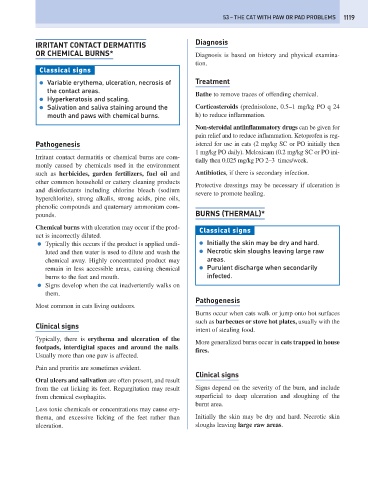Page 1127 - Problem-Based Feline Medicine
P. 1127
53 – THE CAT WITH PAW OR PAD PROBLEMS 1119
IRRITANT CONTACT DERMATITIS Diagnosis
OR CHEMICAL BURNS* Diagnosis is based on history and physical examina-
tion.
Classical signs
● Variable erythema, ulceration, necrosis of Treatment
the contact areas.
Bathe to remove traces of offending chemical.
● Hyperkeratosis and scaling.
● Salivation and saliva staining around the Corticosteroids (prednisolone, 0.5–1 mg/kg PO q 24
mouth and paws with chemical burns. h) to reduce inflammation.
Non-steroidal antiinflammatory drugs can be given for
pain relief and to reduce inflammation. Ketoprofen is reg-
Pathogenesis istered for use in cats (2 mg/kg SC or PO initially then
1 mg/kg PO daily). Meloxicam (0.2 mg/kg SC or PO ini-
Irritant contact dermatitis or chemical burns are com-
tially then 0.025 mg/kg PO 2–3 times/week.
monly caused by chemicals used in the environment
such as herbicides, garden fertilizers, fuel oil and Antibiotics, if there is secondary infection.
other common household or cattery cleaning products
Protective dressings may be necessary if ulceration is
and disinfectants including chlorine bleach (sodium
severe to promote healing.
hyperchlorite), strong alkalis, strong acids, pine oils,
phenolic compounds and quaternary ammonium com-
pounds. BURNS (THERMAL)*
Chemical burns with ulceration may occur if the prod-
Classical signs
uct is incorrectly diluted.
● Typically this occurs if the product is applied undi- ● Initially the skin may be dry and hard.
luted and then water is used to dilute and wash the ● Necrotic skin sloughs leaving large raw
chemical away. Highly concentrated product may areas.
remain in less accessible areas, causing chemical ● Purulent discharge when secondarily
burns to the feet and mouth. infected.
● Signs develop when the cat inadvertently walks on
them.
Pathogenesis
Most common in cats living outdoors.
Burns occur when cats walk or jump onto hot surfaces
such as barbecues or stove hot plates, usually with the
Clinical signs
intent of stealing food.
Typically, there is erythema and ulceration of the
More generalized burns occur in cats trapped in house
footpads, interdigital spaces and around the nails.
fires.
Usually more than one paw is affected.
Pain and pruritis are sometimes evident.
Clinical signs
Oral ulcers and salivation are often present, and result
from the cat licking its feet. Regurgitation may result Signs depend on the severity of the burn, and include
from chemical esophagitis. superficial to deep ulceration and sloughing of the
burnt area.
Less toxic chemicals or concentrations may cause ery-
thema, and excessive licking of the feet rather than Initially the skin may be dry and hard. Necrotic skin
ulceration. sloughs leaving large raw areas.

